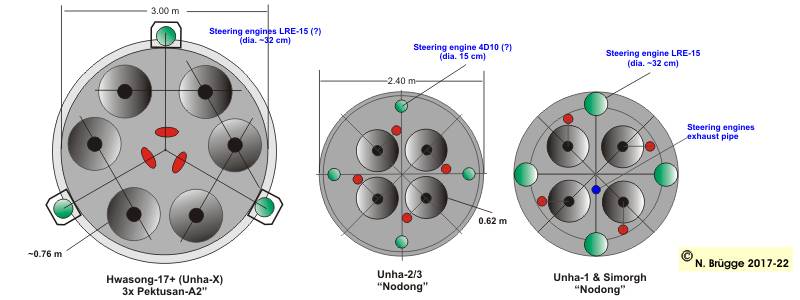

Unha-X

 |
Unha-X |
National Aerospace Development Administration (NADA) * Academy of National Defence Science
2023, May -- The long standstill on the Sohae SLG is an indication that the Unha-X is not a priority at the moment. N.K. do not have a GEO satellite yet. Instead, they initially want to transport smaller observation satellites into a SSO. For this purpose, a launch site is built on the west coast.for the "Chollima-1" launcher.
|
2022, March 16 --
There was probably a failed launch
of a big rocket that day. Debris has fallen near Pyongyang. The failure was
associated with a huge detonation on midair. |
|
|
2017 - 2018 -- Latest end
of 2017 an analyst should be clear that the engine "Pektusan" primarily is
qualified for a future Unha-X, as well as what configuration the future SLV
will have. Equipped with the engine "Pektusan" the HS-12, HS-14 and HS-15
have served in addition to the demonstration of supposedly military strength
also for the qualification of the engine. In the meantime they master the
engine perfectly. It can be equipped with one or two combustors (Pektusan-A1
/ -A2) and was even presented a gimbal type engine (Pektusan-B). It is very
likely that the HS-15 with the gimbal type engine (Pektusan-B) is identical
to a second stage of the Unha-X. For a first stage, three Pektusan-A2 engines
may be used, where, like the RD-250, the turbopump is mounted on a platform.
For control then four additional smaller engines are required. For a third
stage, the engines of the second stage of the Unha-3 are expected to be used. |
|
|
|
Note:
What was previously just a guess, seems to be confirmed: North Korea has at
least blueprints of an old Soviet ICBM engine. The new North Korean engine
"Pektusan" is clearly comparable
to the RD-250 engine of the KB Glushko. Two combustors use a common
turbopump. Typical is the low arrangement of the TP between the nozzles.
|
|
2016, Sept. 20
-- North Korea has successfully conducted the ground test of a
new rocket engine, the country's state
news agency reported. |
|

Engine arrangements in comparison